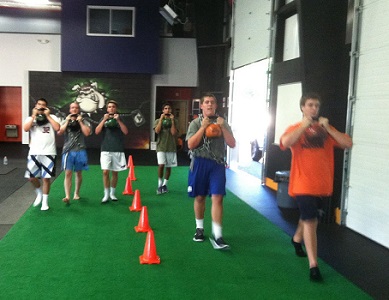A post on High School Strength Programs by Jim Keilbaso

Trying to copy some big time college strength program is common mistake made in high schools. I’ve been engaged in a series of e-mails with a coach about his situation at a high school, and I thought it was worth sharing.
He has been asked to implement a high school strength program for a football team, and the coach has started to voice some strong opinions before anything has even begun. The football coach feels like he’s under some pressure to win because the team has been average for the past three years. He has told the new strength coach that he likes Penn State’s program and wants him to implement it. He also wants to make sure that each kid is getting an individualized strength program program.
The member explained the situation to me, asked for some advice, and here is how I responded:
“First, I would explain to him that your high school strength program can’t copy a college program because you don’t have the staff, equipment or athletes to do it at the high school level. Second, seeing a 5 minute video doesn’t really give you a complete understanding of a college program. Just say that you’re taking things from several colleges and list the ones he wants to hear – Penn State, LSU, Alabama, etc. And, if he wants you to run it like Penn State, ask if he’s going to give you everything it takes to run it like Penn State?
Will he have 5 more coaches there every day?
Can you demand 100% participation from a kid or he’s kicked off the team?

Can you dog-cuss kids left and right if they’re not doing exactly what you say? Can you train them all in small groups instead of all at once before/after school? Will he stand behind you no matter what? Can he tell the parents not to ever talk to you so you can focus on doing your job? Can you spend $500,000 on equipment? Will there be ATCs present at every conditioning session in case kids go down?
That’s what Penn State has available. I’m guessing you don’t. You’re high school strength program just isn’t going to be a college program. More importantly, it doesn’t have to be.
What A High School Strength Program Does Include….
Tell him that you’re going to create a team-wide high school strength program, then individualize from there. There is no need to create a completely different program for every kid.

These are high school athletes. They need BASICS.
So, you create a “workout template” then make adjustments for any kids who need it. Most kids will be just fine with a basic high school strength program, but you have to play politics and say the right things.
Instead of doing complete individual assessments on every kid, you might want to start with some basic strength testing. You can get predicted maxes on a couple of lifts, maybe max chin ups, get numbers on vertical or broad jump, 40s, shuttles, etc. so you have baseline numbers. You want to be able to document progress, so you need to test them periodically to show that your program is working.
The reality of a high school strength program is that you have to get the biggest “bang for your buck” and hope for as much support from your coaches and parents as possible. Anyone who has coached in both college and high school should understand the differences. I hope this helps. Feel free to forward it to your football coach if you think it will help.”

The strength coach had a talk with his football coach, and talked him down from the ledge. It turns out the football coach is stressed because he feels like his job is on the line, and he wants to make sure the kids are getting stronger. The talk this strength coach had with him reassured the football coach that things are going to be OK and that the program is going to work.
Sometimes, we just have to talk stressed out coaches down so they understand we’re on their team, and we want to win just as badly as they do. A conversation like that can go a long way to establishing a relationship with a sport coach, and I think this high school strength coach has done just that. Once this relationship is established, everyone can work together toward the goal of helping the kids reach their true potential.
Ultimately, that’s what this is all about: Developing a High School Strength Program that really works!
Learn how to become a Certfied High School Strength and Conditioning Coach by Clicking Here.
